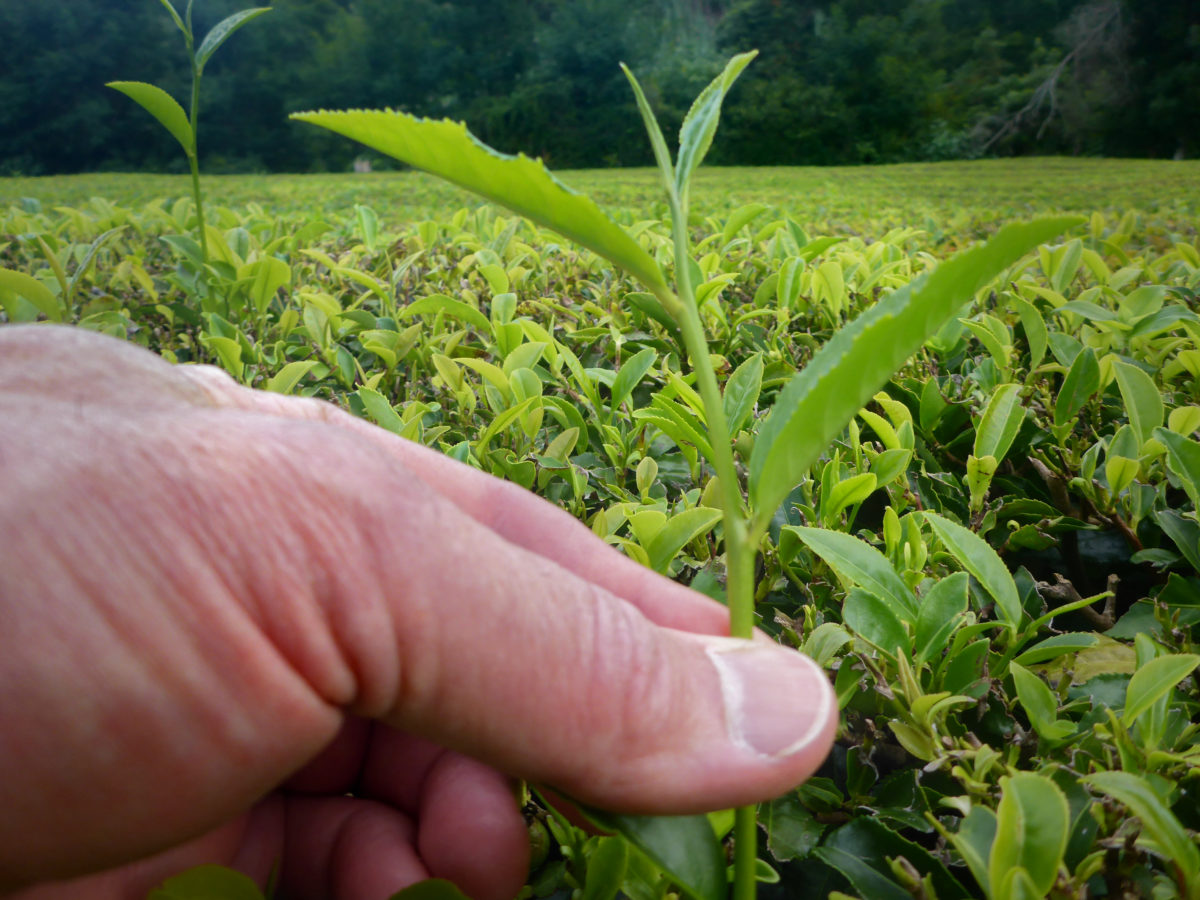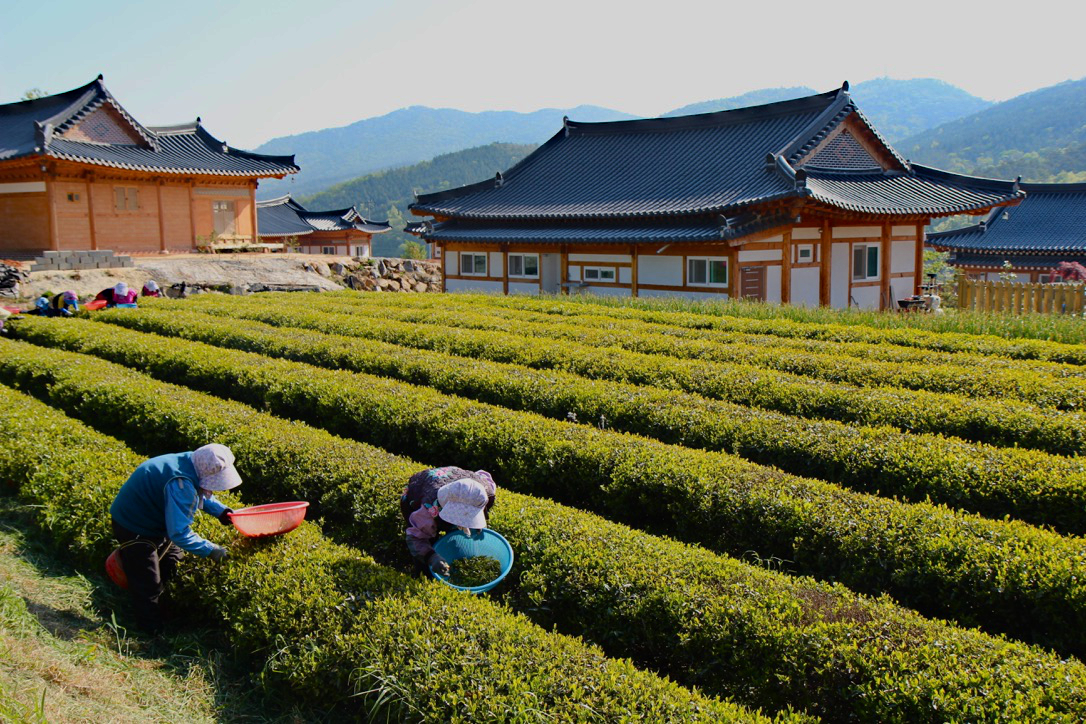- We don’t yet fully understand why time of day matters when plucking tea leaves.
- At dawn leaves wet with dew may take longer for drought responses to set in.
- Differences at mid-day may arise because of the circadian rhythm of aroma volatile production.
- Master tea makers know these patterns and order leaves plucked at just the right time of day from just the right plants to ensure the desired panoply of flavors in the tea.

The tea leaf is like a factory, producing the raw materials that the tea maker then transforms into deliciousness through processing. Each leaf of each plant has a different complement of these raw materials. Through years of observation and practice, master tea makers know which leaves to pluck, and when in the season and at what time of day to pluck them.
See: How Leaves of Different Ages Put Flavor in Your Cup
We don’t yet fully understand why time of day matters. You may argue (correctly) that the amount of dew on the leaf may affect the withering and drying process. The leaf responds to withering as if it were experiencing drought, which leads it to form defense compounds such as the jasmonates with their jasmine-like odor, to warn adjacent leaves and plants of danger; and abscisic acid to close the openings (stomata) on the underside of leaves to reduce water loss. Both jasmonates and abscisic acid serve as a signal for the production of a number of tea aroma compounds. If the leaf is wet with dew, it may take longer for the drought responses to set in, which is why many teas are plucked in the morning well after sun-up and on clear days, when the dew has evaporated.
But why morning?

The dew would surely be gone by afternoon. Are there differences between leaves plucked in the morning and leaves plucked in the afternoon?
There may be two interrelated reasons why there may be differences. The first is the effect of sunlight on photosynthesis and the second is the circadian rhythm of aroma volatile production.
One of the most interesting issues in growing Camellia sinensis for tea is the question of the effects of the amount of sunlight the plant receives. Sunlight drives photosynthesis, yet excessive sunlight turns off photosynthesis in a tea plant. Camellia sinensis, as an evergreen, is what botanists call a “conservative” plant, by which they mean a plant that privileges survival overgrowth. By contrast, “acquisitive” plants grow quickly and then seed and die back annually—they survive by creating the next generation.
Quick growth requires highly active photosynthesis throughout the day. By contrast, for a “conservative” plant like Camellia sinensis, highly active photosynthesis would result in overproduction of sugars at the expense of making the compounds necessary for the plant’s long-term survival under stress. To protect itself during the season when growth potential is greatest, the Camellia sinensis leaf starts to shut down photosynthesis at noon, when sunlight irradiance is greatest. This shutdown persists through sundown. Then at night, the block is lifted so photosynthesis can start up again at dawn. (1)
The mechanisms underlying these switches are not known, but they parallel and may be involved in, the production and emission of aroma-rich volatiles by the leaf. We know that in the presence of insect infestation, the emission of volatile flavor compounds from tea leaves develops a circadian rhythm: the greatest amounts of most of these compounds are produced in the morning and decrease in the afternoon. (2) In Lima beans, it is clear that the production of these defense compounds occurs in response to the burst of photosynthesis at dawn. (3) Whether a similar response to photosynthesis occurs in tea plants is not known but is highly likely.
Dawn comes to plants growing on a hillside at different times in the morning; shading, whether by trees or by deliberate covering, will modify sunlight exposure at dawn and throughout the day. Through experience, the master tea maker knows these patterns and has leaves plucked at just the right time of day from just the right plants to ensure the desired panoply of flavors in the tea.
Footnotes:
(1) Mohotti A.J, Lawlor, D.W. Diurnal variation of photosynthesis and photoinhibition in tea: effects of irradiance and nitrogen supply during growth in the field. Journal of Experimental Botany, 53 (367): 313–322 (2002) doi:10.1093/jexbot/53.367.313.
(2) Cai, X., Sun, X., Dong, W. et al. Herbivore species, infestation time, and herbivore density affect induced volatiles in tea plants. Chemoecology 24: 1–14 (2014) doi:10.1007/s00049-013-0141-2.
(3) Arimura, G-I, Köpke, S., Kunert, M., et al. Effects of Feeding Spodoptera littoralis on Lima Bean Leaves: IV. Diurnal and Nocturnal Damage Differentially Initiate Plant Volatile Emission
Plant Physiology, 146 (3) 965-973 (2008) doi: 10.1104/pp.107.111088.
Tea Market
Get More Value from Your Tea: BRU Maker One
+41794574278
Jacque's Organics
(647) 804-7263
1 thought on “Why Tea Leaves are Plucked in the Morning”